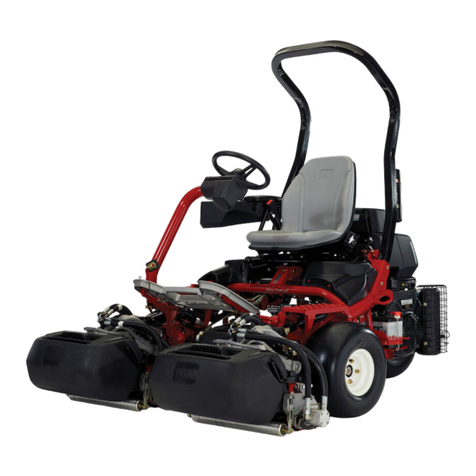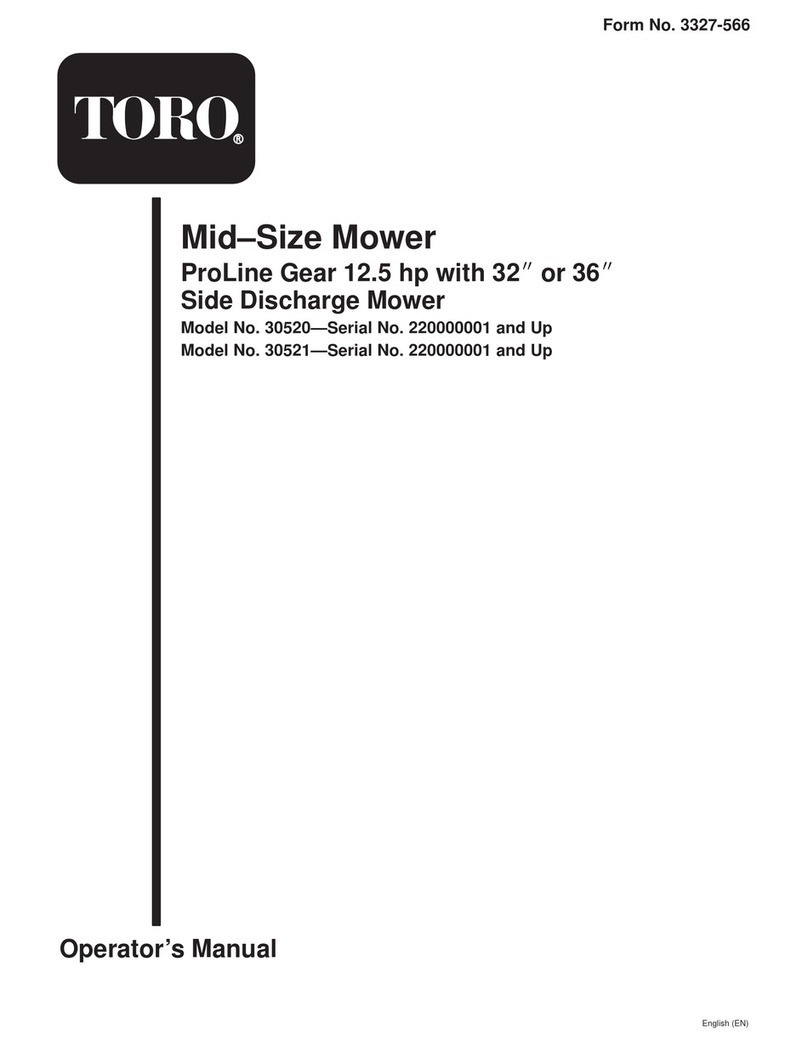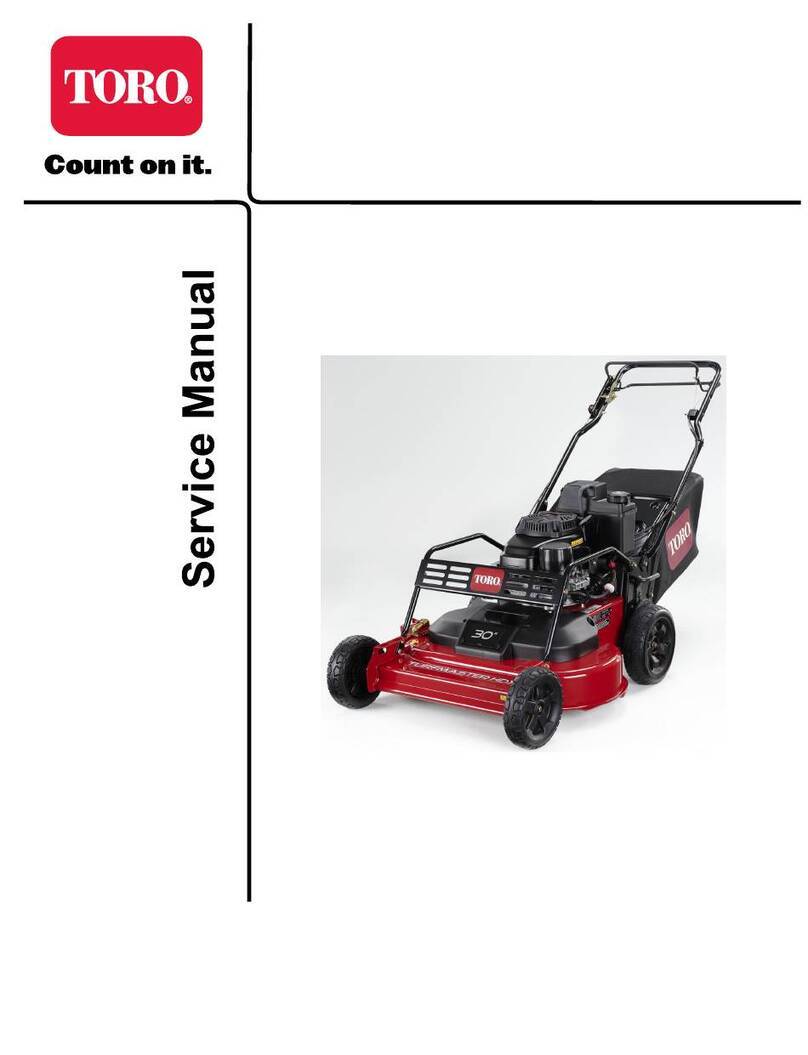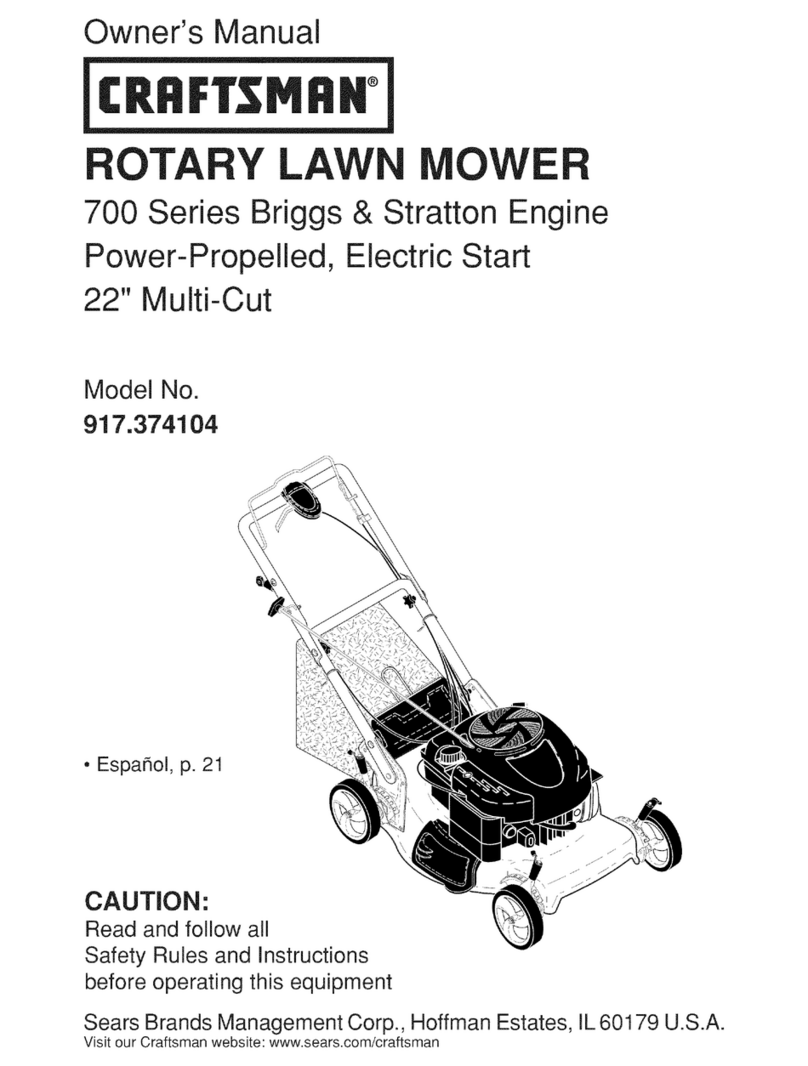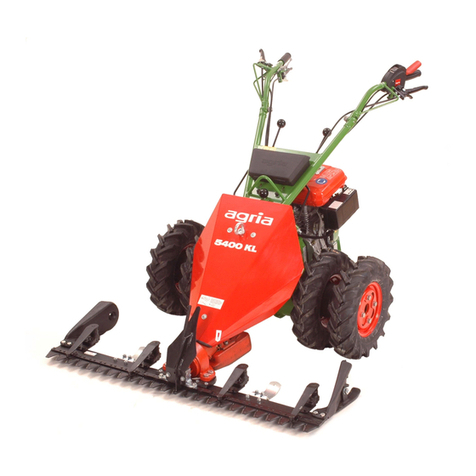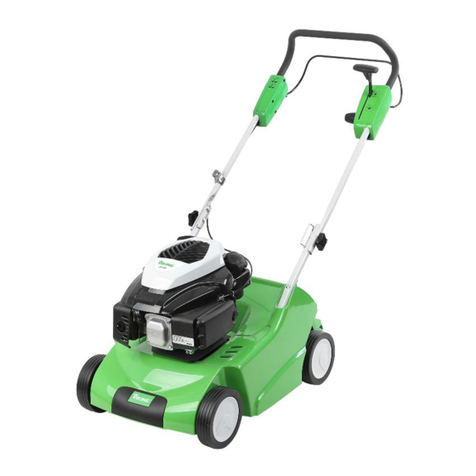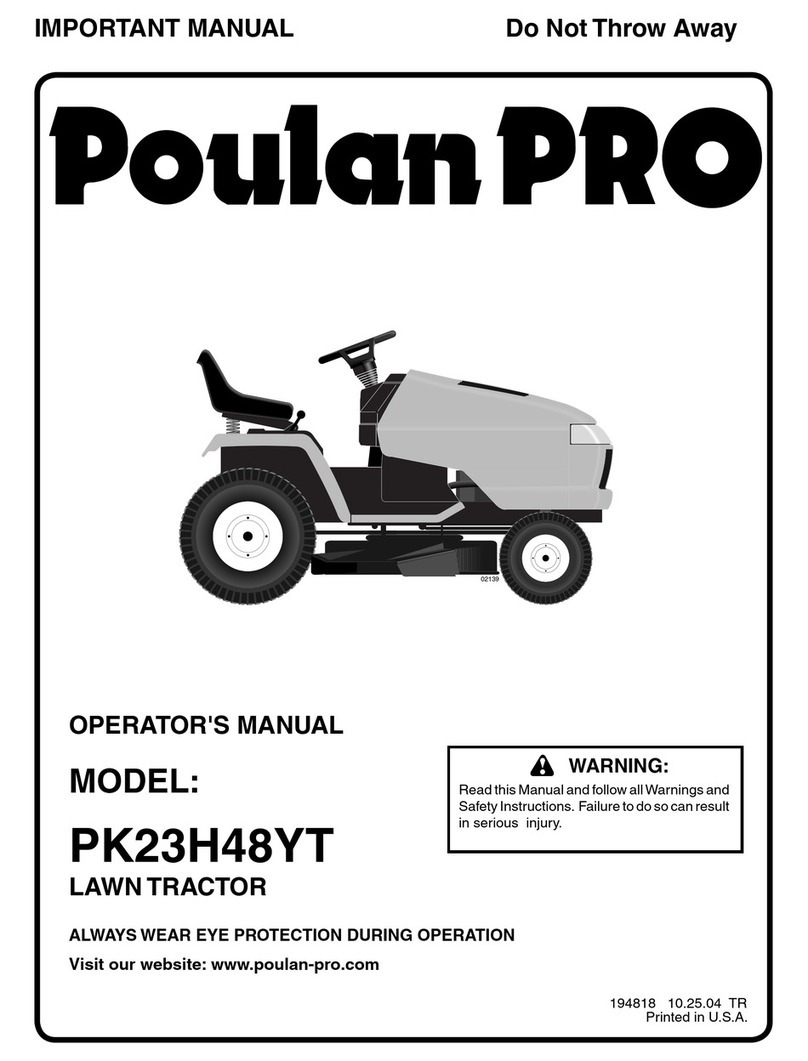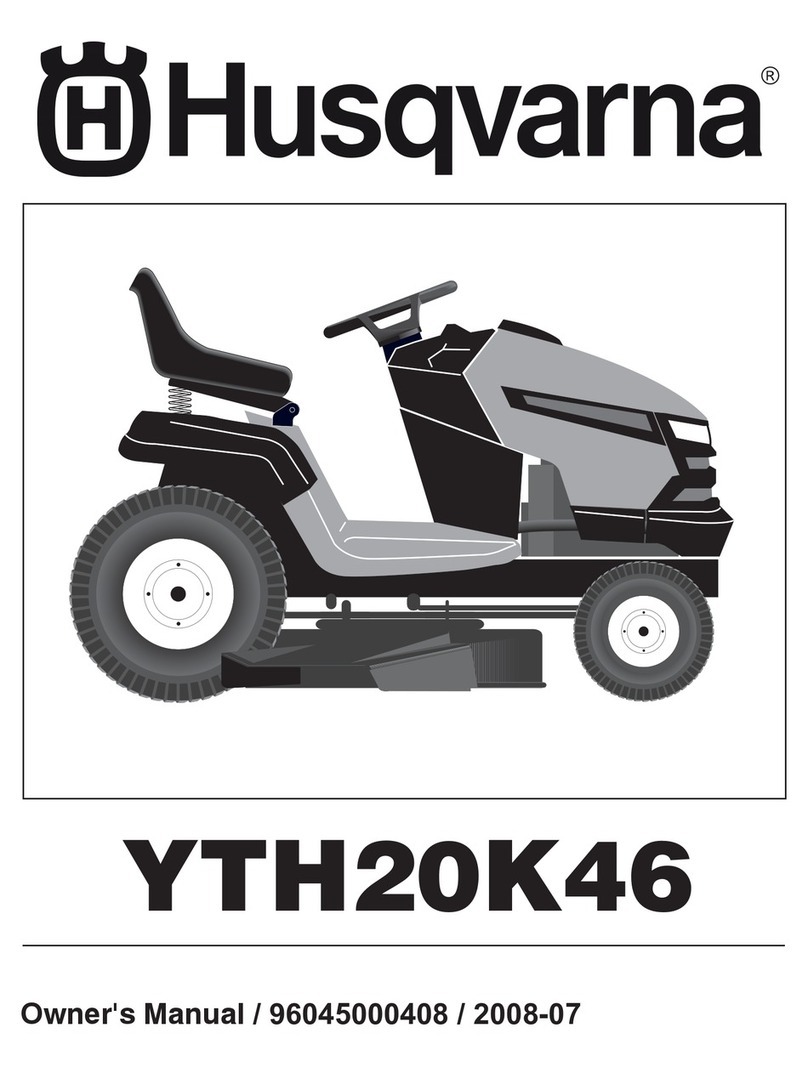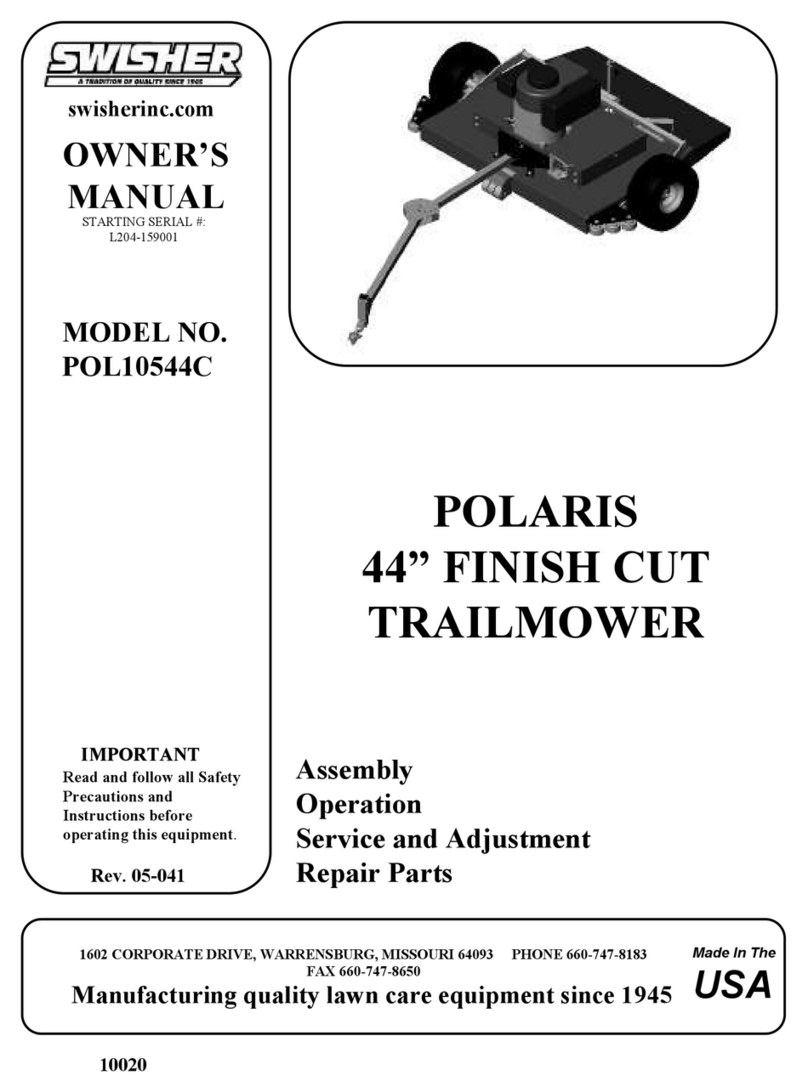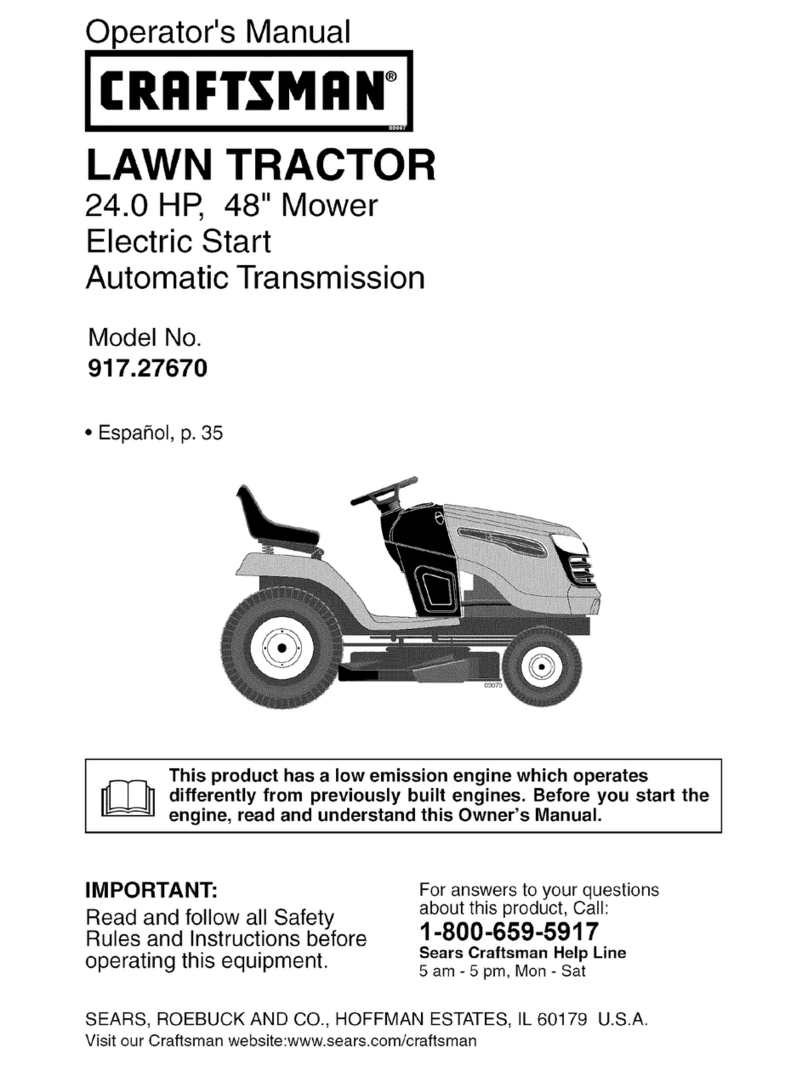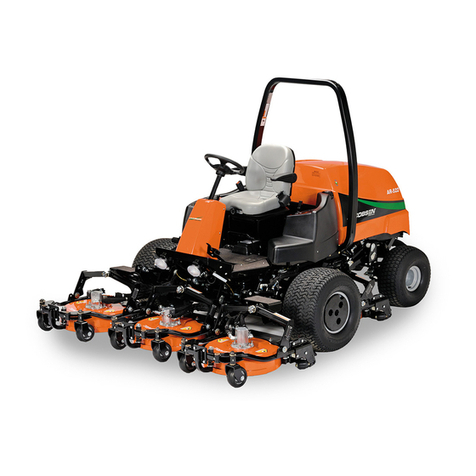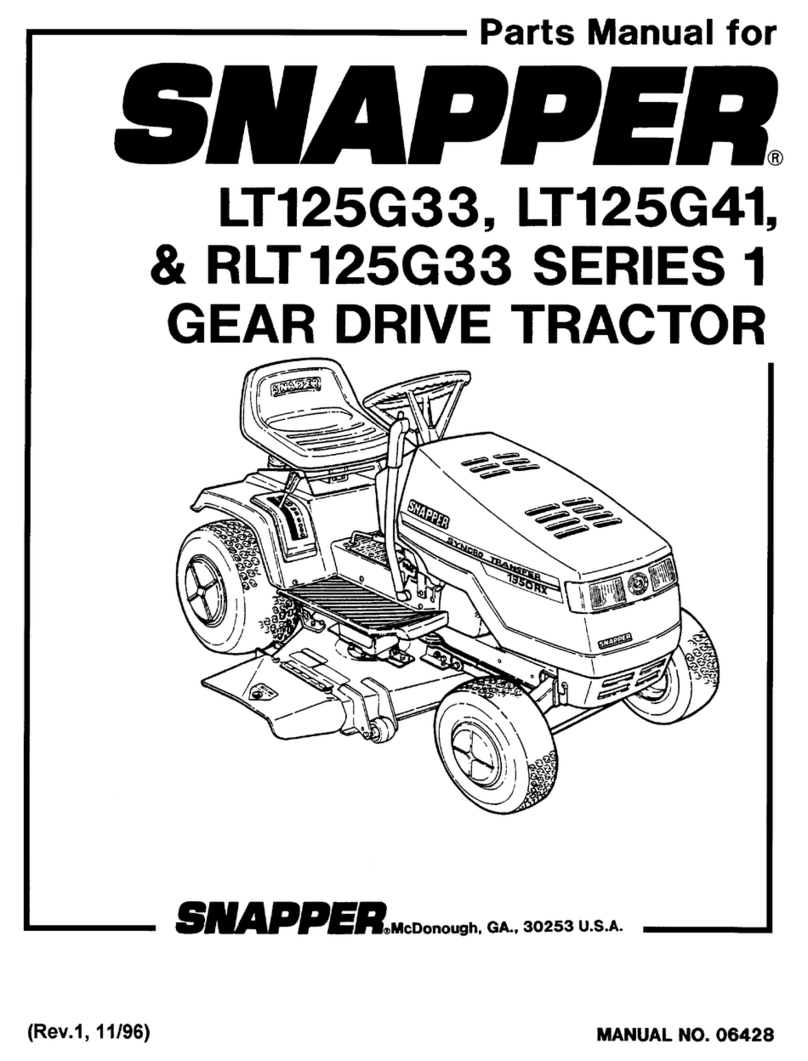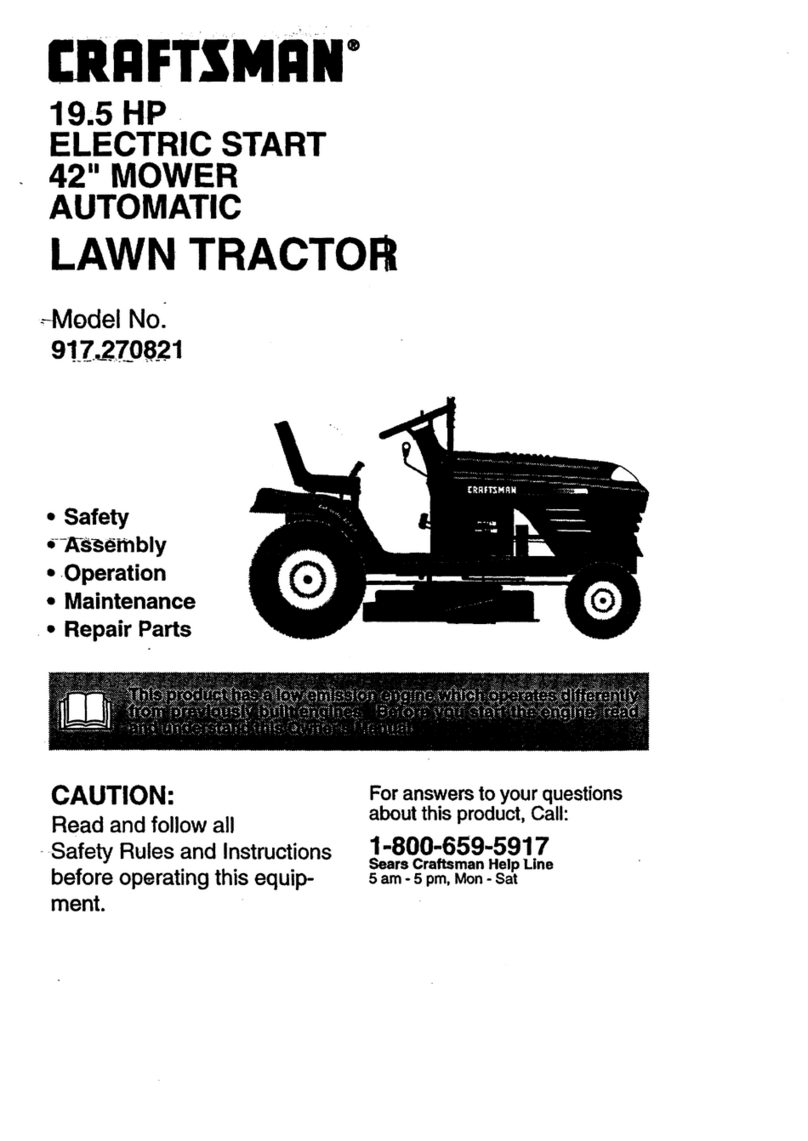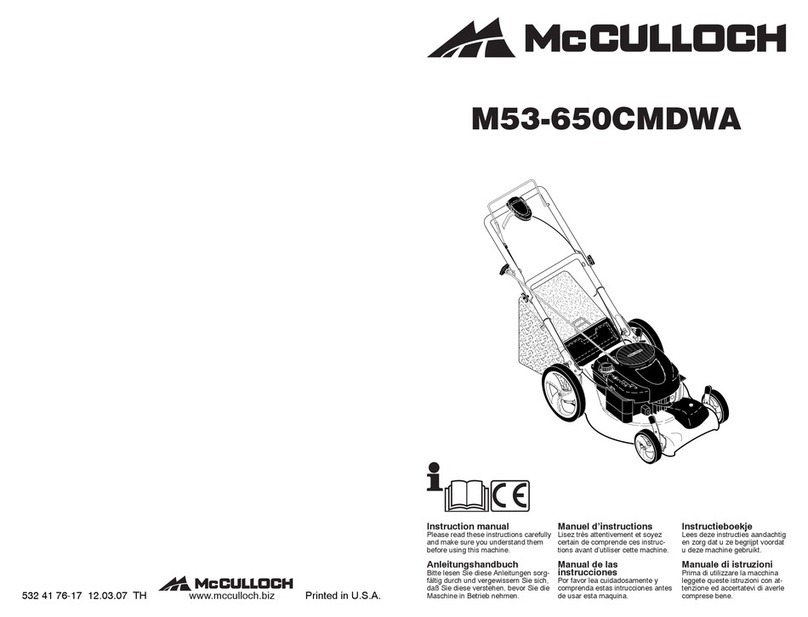Toro GROUNDSMASTER 580-D 30581 User manual

OPERATOR’S
MANUAL
FORM NO. 3324-616 Rev A
MODEL NO. 30581—80001 & UP
GROUNDSMASTER®580-D
®
© The TORO Company 1999
To understand this product, and for safety
and optimum performance, read this
manual before starting operation. Pay
special attention to SAFETY
INSTRUCTIONS highlighted by this
symbol.

2
FOREWORD
This operator’s manual has instructions on safety, proper set-up and operation, adjustments and maintenance. Therefore,
anyone involved with the product, including the operator, should read and understand this manual. This manual
emphasizes safety, mechanical and general product information. DANGER, WARNING and CAUTION identify safety
messages. Whenever the triangular safety alert symbol appears, understand the safety message that follows. For complete
safety instructions, read pages 3–5. IMPORTANT highlights special mechanical information and NOTE emphasizes
general product information worthy of special attention.
Whenever you have questions or need service, contact your local authorized Toro Distributor. In addition to having a
complete line of accessories and professional turf care service technicians, the distributor has a complete line of genuine
TORO replacement parts to keep your machine operating properly. Keep your TORO all TORO. Buy genuine TORO
parts and accessories.
SAFETY INSTRUCTIONS 3
SYMBOL GLOSSARY 6
SPECIFICATIONS 9
BEFORE OPERATING 11
CONTROLS 16
OPERATING INSTRUCTIONS 20
MAINTENANCE 27
IDENTIFICATION AND ORDERING 47
TABLE OF CONTENTS

Training
1. Read the instructions carefully. Be familiar with the
controls and the proper use of the equipment.
2. Never allow children or people unfamiliar with
these instructions to use the lawn mower. Local
regulations may restrict the age of the operator.
3. Never mow while people, especially children, or
pets are nearby.
4. Keep in mind that the operator or user is responsible
for accidents or hazards occurring to other people or
their property.
5. Do not carry passengers.
6. All drivers should seek and obtain professional and
practical instruction. Such instruction should
emphasize:
• the need for care and concentration when
working with ride-on machines;
• control of a ride-on machine sliding on a slope
will not be regained by the application of the
brake. The main reasons for loss of control are:
– insufficient wheel grip;
– being driven too fast;
– inadequate braking;
– the type of machine is unsuitable for its
task;
– lack of awareness of the effects of ground
conditions, especially slopes;
– ##incorrect hitching and load distribution.
Preparation
1. While mowing, always wear substantial footwear
and long trousers. Do not operate the equipment
when barefoot or wearing open sandals.
2. Thoroughly inspect the area where the equipment is
to be used and remove all objects which may be
thrown by the machine.
3. WARNING—Petrol is highly flammable.
• Store fuel in containers specifically designed
for this purpose.
• Refuel outdoors only and do not smoke while
refueling.
• Add fuel before starting the engine. Never
remove the cap of the fuel tank or add petrol
while the engine is running or when the engine
is hot.
• If petrol is spilled, do not attempt to start the
engine but move the machine away from the
are of spillage and avoid creating any source of
ignition until petrol vapors have dissipated.
• Replace all fuel tanks and container caps
securely.
4. Replace faulty silencers.
Operation
1. Do not operate the engine in a confined space where
dangerous carbon monoxide fumes can collect.
2. Mow only in daylight or in good artificial light.
3. Before attempting to start the engine, disengage all
blade attachment clutches and shift into neutral.
4. Do not use on slopes of more than:
• Never mow side hills over 5°
• Never mow uphill over 10°
• Never mow downhill over 15°
5. Remember there is no such thing as a “safe” slope.
Travel on grass slopes requires particular care. To
guard against overturning:
• do not stop or start suddenly when going up or
downhill;
• engage the clutch slowly, and always keep the
machine in gear, especially when travailing
downhill;
• machine speeds should be kept low on slopes
and during tight turns;
• stay alert for bumps and hollows and other
hidden hazards;
3
Safety Instructions

• never mow across the face of the slope, unless
the lawn mower is designed for this purpose.
6. Use care when pulling loads or using heavy
equipment.
• Use only approved drawbar hitch points.
• Limit loads to those you can safely control.
• Do not turn sharply. Use care when reversing.
• Use counterweight(s) or wheel weights when
suggested in the instruction handbook.
7. Watch out for traffic when crossing or near
roadways.
8. Stop the blades rotating before crossing surfaces
other than grass.
9. When using any attachments, never direct discharge
of material toward bystanders nor allow anyone near
the machine while in operation .
10. Never operate the lawn mower with defective
guards, shields or without safety protective devices
in place.
11. Do not change the engine governor settings or
overspeed the engine. Operating the engine at
excessive speeds may increase the hazard of
personal injury.
12. Before leaving the operator’s position:
• disengage the power take-off and lower the
attachments;
• change into neutral and set the parking brake;
• stop the engine and remove the key.
13. Disengage the drive to attachments when
transporting or not in use.
14. Stop the engine and disengage the drive to the
attachment
• before refueling;
• before removing the grass catcher;
• before making height adjustments unless the
adjustment can be made from the operator’s
position.
• before clearing blockages;
• before checking, cleaning or working on the
lawn mower;
• after striking a foreign object. Inspect the lawn
mower for damage and make repairs before
restarting and operating the equipment.
15. Reduce the throttle setting during engine runout
and, if the engine is provided with a shutoff valve,
turn the fuel off at the conclusion of mowing.
Maintenance and Storage
1. Keep all nuts, bolts and screws tight to be sure the
equipment is in safe working condition.
2. Never store the equipment with petrol in the tank
inside a building where fumes may reach an open
flame or spark.
3. Allow the engine to cool before storing in any
enclosure.
4. To reduce the fire hazard, keep the engine, silencer,
battery compartment and petrol storage area free of
grass, leaves, or excessive grease.
5. Check the grass catcher frequently for wear or
deterioration.
6. Replace worn or damaged parts for safety.
7. If the fuel tank has to be drained, this should be
done outdoors.
8. Be careful during adjustment of the machine to
prevent entrapment of the fingers between moving
blades and fixed parts of the machine.
9. On multi-bladed machines, take care as rotating one
blade can cause other blades to rotate.
10. When the machine is to be parked, stored or left
unattended, lower the cutting means unless a
positive mechanical lock is used.
Sound &Vibration Levels
Sound Levels
This unit has an equivalent continuous A-weighted sound
pressure at the operator ear of: 81 dB(A), based on
measurements of identical machines per 84/538/EEC.
Safety Instructions
4

Vibration Levels
This unit has a vibration level of 2.5 m/s2at the posterior,
based on measurements of identical machines per ISO
5349 procedures.
This unit does not exceed a vibration level of 0.5 m/s2at
the posterior based on measurements of identical
machines per ISO 2631 procedures.
Safety Instructions
5

6
Symbol Glossary
Caustic liquids,
chemical burns to
fingers or hand
Poisonous
fumes or toxic
gases, asphyxiation
Electrical shock,
electrocution High pressure
fluid, injection
into body
High pressure
spray, erosion of
flesh
High pressure
spray, erosion of
flesh
Crushing of
fingers
or hand,
force
applied from
above
Crushing of
toes or foot, force
applied from above
Crushing of
whole body,
applied from
above
Crushing of
torso, force
applied from side
Crushing of fingers
or hand/, force
applied from side
Crushing of
whole body Crushing of
head, torso and
arms
Cutting of
fingers or hand Cutting of footCrushing of leg,
force applied
from side
Severing of
fingers or hand,
mower blade
Severing of
toes or foot,
mower blade
Severing of
toes or fingers,
rotary mower
blade
Cutting or
entanglement of
foot, rotating auger
Severing of
foot, rotating
knives
Severing of
fingers or hand,
impeller blade
Dismember-
ment, front engine
mower in forward
motion
Dismember-
ment, front engine
mowerin rearward
motion
Severing of
fingers or hand,
engine fan
Whole body entanglement,
implement input drive line Fingers or
hand entangle-
ment, chain
drive
Hand & arm
entanglement,
belt drive
Thrown or flying
objects, whole
body exposure
Thrown or
flying objects,
face exposure
Thrown or flying
objects, rotary
mover
Runover/back-
over, vehicle Machine
tipping, riding
mower
Machine rollover,
ROPS (rear
engine mower)
Stored energy
hazard, kickback
or upward motion
Hot surfaces,
burns to fingers
or hands
Explosion Fire or open
flame
Secure lifting
cylinder with locking
device before getting
in hazardous area
Do not step on
loading platform
if PTO is connect-
ed to tractor &
engine is running
Do not step Wait until all
machine comp-
onents have
completely
stopped before
touching them
Shut off engine
& remove key
before perform-
ing maintenance
or repair work
Stay a safe
distance from
the machine
Stay clear of
articulation area
while engine is
running
Do not open
or remove safety
shields while
engine is
running
Riding on this
machine is allowed
only on a passen-
ger seat & only if the
driver’s view is not
hindered

Safety Instructions
7
Fasten seat
belts Safety alert
triangle Outline safety
alert symbol Read operator’s
manual Fire, open light
and smoking
prohibited
Eye protection
must be worn
Consult technical
manual for proper
service
procedures
Hearing
protection must
be worn
Caution, toxic
risk
Head protection
must be worn Flush with water Engine Transmission Hydraulic systemFirst aid
Oil Coolant (water) Intake air Exhaust gas Pressure Level indicator Liquid level
Brake system
Disengage
Filter Temperature Failure/
Malfunction Start switch/
mechanism On/start Off/stop Engage
Plus/increase/
positive polarity Minus/decrease/
negative polarity Horn Battery charging
condition Hourmeter/
elapsed operating
hours
Fast Slow Continuous
variable, linear
Volume empty Volume full Machine travel
direction,
forward/
rearward
Control lever
operating
direction, dual
direction
Control lever
operating
direction, multiple
direction
Clockwise
rotation Counter-clock-
wise rotation Grease
lubrication
point
Oil lubrication
point Lift point Jack or
support point Draining/
emptying Engine lubricat-
ing oil Engine
lubricating
oil pressure
Engine lubricating
oil level Engine lubricating
oil filter
Engine lubricating
oil temperature Engine coolant Engine coolant
pressure Engine coolant
filter Engine coolant
temperature Engine intake/
combustion air
Engine intake/com-
bustion air pressure
Engine intake/air
filter

8
Engine start Engine stop Engine failure/
malfunction Engine rotational
speed/frequency Choke Primer (start aid) Electrical preheat
(low temperature
start aid)
n/min
Transmission
oil
Transmission
oil pressure Transmission
oil temperature Transmission
failure/malfunctionClutch Neutral High Low Forward
NHLF
Reverse Park First gear Second gear
Third gear (other #'s
may be used until the
maximum # of forward
gears is reached.)
Hydraulic oil Hydraulic oil
pressure Hydraulic oil
level
RP 231
Hydraulic oil
filter Hydraulic oil
temperature Hydraulic oil
failure/malfunction Fuel level
Parking brake Fuel Fuel filter Fuel system
failure/malfunction
Lock Unlock Differential lock 4-Wheel drive Power Take-OffDiesel fuel Unleaded fuel Headlights
Cutting unit,
lower Cutting unit,
hold Cutting unit,
float
Cutting unit Cutting unit,
raise
Power Take-Off,
rotational speed Blade cutting
element Blade cutting
element, height
adjustment
Cutting unit,
transport
position
Cutting unit,
raise to transport
position
Cutting unit,
lower to transport
position
Attachment
lower Attachment
raise Spacing distance Snow thrower,
collector auger Traction
Above working
temperature
range
Drilling Manual metal
arc welding Manual Water pump Keep dry Weight Do not dispose
in the garbage CE logo
Symbol Glossary, continued

CUTTING UNITS
Cutting Unit Drive System:All hydraulic drive. Initial
cutting drive engagement via electric switch. Drive shuts off
or engages individually as cutting units are raised or
lowered.
Automatic Weight Transfer: Patented automatic weight
transfer from decks to traction unit under demanding
traction situations for improved traction and deck floatation.
Cutting Unit Configuration: A 234 cm Triflex front center
cutting unit and two 145cm outboard cutting units.
Mowing Rate/Width: Mows up to 5.9 hectares at 12.1
km/hr using all cutting units (assumes no overlap and
stops).
Total Cutting Width: 488 cm.
Height-of-Cut Range: 2.5–10.2 cm. High 6.3–14 cm.
Blades: Interchangeable heat-treated steel blades, 50.8 cm
long, 6.3 mm thick and 6.3 cm wide. Five blades on the
Triflex and three each on the outboard unit.
Anti-scalp Devices: Cutting units equipped with adjustable
skids. Anti-scalp cup on each blade assembly.
TRIFLEX CUTTING UNIT (FRONT)
Type: Triflex front mounted rotary cutting unit with 5-blade
spindles and 234 cm width of cut.
Trimming Ability: Trims to either side. 20.3 cm cutting
unit offset from the outside of the wheel to trim side of
front cutting unit on either side.
Height-of-Cut Adjustment: 12.7 mm increments by
spacers on front castor shafts and clevis pins on rear wheel
forks.
Cutter Drive: Hydraulic gear motor. “BB” hex section belt
to center cutting unit spindles, “B” section belt to wings.
Splined shafts, each in two greaseable, tapered roller
bearings in cast iron housings (greaseable from the top).
Self-tensioning, permanently lubricated belt idlers.
Castor Wheels: Two 10.50 x 3.50 and two 12 x 5.00 heavy
duty, pneumatic castor wheels.
OUTBOARD CUTTING UNITS
Type: Two, three-spindle, side-mounted rotary cutting
units, each with a 145 cm width of cut.
Trimming Ability: Trims to either side. 147cm cutting unit
is offset from the outside of the wheel to trim the side of
side cutting units.
Height-of-Cut Adjustment: 12.7 mm increments by
spacers on all castor shafts.
Cutter Drive: Hydraulic gear motor. Three “B” section
belts to spindles.
Castor Wheels: Four 10.50 x 3.50 heavy-duty,
interchangeable, pneumatic castor wheels.
Cutting Unit Suspension: Outboard cutting unit arms pivot
from the center, sweep the cutting units forward in mow
and lift, and rotate the cutting units down and back when in
transport. Arms have rubber mount design for shock
absorption and more cutting unit floatation (patented).
Adjustable, spring-loaded, breakaway arms release and
rotate outboard cutting unit upon accidental impact.
Automatically reset when cutting unit is raised. Cam lock
links automatically secure outboard cutting units in
transport position.
Machine Width (Approx.):
Transport—241 cm.
Mow—495 cm.
Machine Height (Approx.):
Transport—231 cm—to the top of raised cutting units.
Mow—152 cm—to top of seat back.
Machine Overall Length (Approx.): 427 cm.
Total Weight (with fluids) [Approx.]: 2967 kg.
Accessories:
2-Post Roll-Over Protection System
Canopy option
Canopy w/windshield option
Cab with Roll-Over Protection System
Road Light Package
244 cm Rotary Broom
Air Conditioning
7-Foot Snow blower
9
Specifications

Leaf Mulcher
Cold Start Kit
Foam Filled Castor Tires
Extra Traction Drive TireSpecifications and design
subject to change without notice.
Specifications
10

11
CHECK BATTERIES (Initial
preparation)
1. Unlatch the hood and left-hand engine side panel
(Fig. 1). Raise and prop the hood open and remove
the left side panel. Make sure the hood prop is
secured in one of the mounting brackets on the
hood.
Figure 1
1. Engine hood
2. Left side panel
3. Hood latches
4. Side panel latch
2. Remove the capscrews securing the battery tray and
slide the tray out (Fig. 2).
3. Check both batteries for charge with a hydrometer.
If the batteries check acceptably, slide the tray back
in place, secure it with capscrews and lockwashers
and install the side panel. If the batteries require
charging, go to step 4.
4. Remove the negative (–) battery cables from the
batteries (Fig. 2). Connect a 3- to 4-amp battery
charger to the posts. Charge the batteries at a rate
of 3 to 4 amperes for 4 to 8 hours.
5. When the batteries are fully charged, disconnect the
charger from the electrical outlet and battery posts.
6. Install the negative (–) cable ends, slide the tray
back in place, secure it with capscrews and install
the side panel.
Figure 2
1. Battery tray
2. Tray mounting holes
3. Negative (–) connections
4. Positive (+) connections
5. Battery tray mounting screws
CHECK ENGINE OIL (DAILY)
The engine is shipped with 10L of oil in the crankcase.
However, check the oil level before and after the engine is
first started.
1. Be sure the machine is positioned on a level surface.
2. Unlatch the hood and raise and prop it open (Fig.
1). Make sure the hood prop is secured in one of the
mounting brackets on the hood.
3. Remove the dipstick, wipe it with a clean cloth (Fig.
3) and insert it into the tube until it is fully seated.
Remove the dipstick from the tube and check the oil
level. If the oil level is low, remove the filler cap
(Fig. 4). Add oil until the level is to the top notch
on the dipstick. DO NOT OVERFILL.
Before Operating
Wear safety goggles and rubber gloves when working
with the batteries. Charge batteries in a well-ventilated
place so the gases produced while charging can dissipate.
Since the gases are explosive, keep electrical sparks and
open flames away from the batteries. Do not smoke.
Nausea may result if the gases are inhaled. Unplug the
charger from the electrical outlet before connecting to or
disconnecting charger leads from the battery posts.
CAUTION

Before Operating
12
Figure 3
1. Dipstick
The engine uses any high-quality detergent oil having the
American Petroleum Institute—API—“service
classification” CD. Oil viscosity recommendations are:
AMBIENT TEMPERATURE PROPER
VISCOSITY
–28.9° to –6.7°C SAE 10
–6.7° to 40.6°C SAE 30
40.6° C and up SAE 40
Note: Do not use multi-viscosity oils.
Figure 4
1. Engine Oil Fill Cap
IMPORTANT: Check oil after every 5 hours operation,
or daily. Change the oil and filter after the first 50
hours, then change both every 100 hours operation
thereafter. Change the oil and filter more often when the
engine is operated in extremely dusty or dirty
conditions.
5. Insert the dipstick into the tube and close and latch
the hood.
CHECKTHE COOLING SYSTEM
(DAILY)
The cooling system is filled with a 50/50 solution of water
and permanent ethylene glycol anti-freeze. Check the
coolant level at the beginning of each day before starting
the engine. Capacity of the cooling system is 14.7 L.
1. Unlatch, raise and prop the hood open. Make sure
the hood prop is secured in one of the mounting
brackets on the hood.
2. Remove the radiator cap (Fig. 5). Coolant level
must be above the radiator core and about 25mm
below the bottom of the filler neck.
Figure 5
1. Radiator Cap
3. If coolant level is low, add a 50/50 mixture of water
and ethylene glycol anti-freeze. DO NOT USE
ALCOHOL/METHANOL-BASE COOLANTS
OR WATER ONLY. DO NOT OVERFILL.
4. Install the radiator cap, close and latch the hood.
The best time to check the coolant level is each day
before the engine has been started because the coolant
system has not been pressurized. When the engine is hot
and the radiator cap is removed, pressurized coolant can
escape and cause burns. If engine coolant is hot, slowly
and carefully remove the radiator cap.
CAUTION

Before Operating
13
CHECK HYDRAULIC SYSTEM
FLUID (DAILY)
1. Fluid level should be checked daily through the
sight glass at the rear of the hydraulic reservoir
(Fig. 6). When oil is cold, the level will be slightly
below center, but it should be in the middle of the
sight glass when the oil is warm.
Figure 6
1. Hydraulic Oil Level Sight Glass
2. Reservoir Fill Cap
2. If the oil level is low, add hydraulic oil to the
reservoir (Fig. 6); refer to Machine Fluid
Recommendations.
FILLTHE FUELTANK
1. Remove the fuel tank cap (Fig. 7).
2. Fill the tank to about 25mm below bottom of filler
neck with No. 2 diesel fuel. Install the cap.
Figure 7
1. Fuel Tank Cap
CHECKTIRE PRESSURE (DAILY)
Since the Groundsmaster 580-D can be operated under
many different turf conditions, proper tire pressure is
important. Use the following as a guide:
Under Normal mowing conditions and when used on
a wide variety of turf grasses—103.4 kPa front; 89.6
kPa rear. 344.7 kPa castors.
When turf is wet and softer than normal—use low
pressure: 82.7 kPa front and 62 kPa rear.
When turf is dry and harder than normal, use higher
tire pressure: 124 kPa front and rear.
IMPORTANT: Do not operate in HIGH RANGE for
extended periods when tire pressure is less than 18 psi
because tires may be damaged. When tire pressure
exceeds 18 psi, HIGH RANGE may be used.
CHECK SYSTEMS OPERATION
(DAILY)
Start the engine. Move the Groundsmaster 580-D, slowly to
an area where the machine can be checked for proper
function. Check operation of controls, safety interlock
system, engine, hydraulic system, brakes and cutting units.
Refer to the Know Your Controls and Operating
Instructions sections for proper procedures.
CHECKING CUTTING UNIT
MISMATCH
To assure all cutting units are at the same height of cut:
1. Adjust all cutting units to the highest height of cut.
Because diesel fuel is flammable, use caution
when storing or handling it. Do not smoke while
filling the fuel tank. Do not fill fuel the tank
while engine is running, hot, or when the machine
is in an enclosed area. Always fill the fuel tank
outside and wipe up any spilled diesel fuel before
starting the engine. Store fuel in a clean, safety-
approved container and keep the cap in place.
Use diesel fuel for the engine only; not for any
other purpose.
DANGER

Position all castor arm height-of-cut spacers to on
the underside of the castor arms. Do not move
washers. Leave them in their original position.
Note: Unless all castor wheel axles are not in the
same location, axles do not have to be relocated.
All, however, must be in the same holes (Fig. 8).
2. Place a flat sheet of plywood at least 2mm thick and
at least 1.2m x 2.4 m on a level surface and lower
the cutting unit onto the plywood.
3. Taking each cutting blade in turn, position the blade
so it faces fore and aft. Measure from plywood to
the front tip of the cutter blade and record
dimension. All blade heights on the same deck
should be within 6.3 mm of one another. If blade
heights meet criteria, proceed to step 5. If blade
heights are not within 6.3 mm, proceed to step 4.
4. To match cutting blade height, transfer washers
from one side of a castor wheel arm to the other. If
end is to be lowered, transfer one or both washers
from the underside to the top. By contrast, if end is
to be raised, transfer washer(s) from the top to the
underside. Each washer is 3 mm thick. Repeat
measurement of blade tip height and record new
dimensions.
5. Repeat steps 2–3 on the remaining cutting units, and
step 4, if necessary. If washers are transferred on a
outboard cutting unit castor arm, be sure to transfer
the same number on both ends of the castor arm.
6. Compare blade height dimensions of all cutting
units. Blade heights must be within 9.5 mm of one
another. If they are not, determine which cutting
unit height can be changed to compensate for
difference and either transfer washers from bottom
to top to lower unit, or from top to bottom to raise.
Transfer an equal number of washers at all castor
wheel locations to keep cutting unit level -two on
front unit, four on outboard units.
ADJUSTING HEIGHT OF CUT
The height of cut is adjustable from 25 to 140 mm in 13mm
increments. Positioning the castor wheel axles in the top
holes of the castor forks (Fig. 8) allows low-range height-
of-cut settings from 25 to 102 mm; positioning the castor
wheel axles in the lower holes of the castor forks (Fig. 8)
allows high-range height-of-cut settings from 63.5 to 140
mm.
Figure 8
1. Low range
2. High range
3. Spacers
4. Height of cut
1. Start the engine, position the machine on a level
surface, lower the cutting units to a point where the
castor wheels can be removed from the arms, set the
lift levers in neutral, set the parking brake and shut
off the engine. Remove the ignition key to prevent
accidental startup.
2. Position the castor wheel axles on all cutting units
in the same hole in the castor forks.
3. On the front cutting unit, remove the hairpin cotter
and clevis pins from the rear castor pivot arms (Fig.
9). Align the pivot arm holes with selected
height-of-cut bracket holes in the deck frames,
insert the clevis pins and install the hairpin cotters
(Fig. 9).
Figure 9
1. Hairpin cotter
2. Clevis pin
3. Castor axle mount holes
4. Pivot arm
4. On all remaining castor wheel assemblies, remove
the lynch pin from the castor fork shafts (Fig. 10).
Before Operating
14

Remove the castor fork shaft and spacer assembly
from the castor arm (Fig. 10). Place spacers onto
the castor spindle to the desired height-of-cut
setting and install the castor fork shaft in arm (Fig.
9). Install the remaining spacers onto the shaft and
secure the assemblies with the lynch pin (Fig. 10).
Figure 10
1. Lynch pin
2. Spacers
3. Washers
ADJUSTING SKIDS
After the initial set up or if height of cut is changed, deck
skids should also be adjusted. Adjust skids by loosening the
flange lock nuts (Fig. 11), positioning the skid at the
specified height (see chart) and re-tightening the flange lock
nuts.
Front Cutting Unit
All height of cut—0.95cm to 1.2 cm above level surface
Outboard Cutting Units
2.5 cm height of cut—Skid positioned all the way up
3.8 cm to 7.6 cm height of cut—Skid positioned 1.2 cm to
2.5 cm above level surface.
7.6 cm and above height of cut—Skid positioned all the
way down,
Figure 11
1. Skid
Before Operating
15

Seat (Fig. 12)—Pull the seat adjusting lever (right side)
outward, slide the seat fore or aft to the desired position and
release the lever to lock the seat in position. The seat moves
15 cm fore and aft in 15mm increments. The knob at the
lower center provides variable weight adjustment from
49.9–129.3 kg.
Figure 12
1. Seat adjusting lever
2. Weight adjusting knob
3. Weight indicator
Seat height adjusts vertically to three positions. To raise: lift
the seat to the first or second click stop; to lower: lift the
seat to the highest position, then lower it to the lowest
position. The arm rests pivot up and down.
Warning Light Check Switch (Fig. 13)—Before
beginning operation, press the switch button. All lights on
the control panel should light. If a light fails to illuminate,
there is an electrical malfunction requiring immediate
repair.
Engine Oil Pressure Warning (Fig. 13)—Dangerously
low engine oil pressure is indicated by both a warning
indicator light and an audible signal. When this occurs, stop
the engine immediately avoid engine damage.
No Charge Warning (Fig. 13)—No charge to the batteries
is indicated by a warning indicator light and audible signal.
Fuel System Warning (Fig. 13)—A warning indicator light
and audible signal warn of water in the fuel and need for
service.
Coolant Temperature Warning (Fig. 13)—If engine
coolant temperature exceeds 101° C, a warning indicator
light illuminates and an audible signal sounds. If coolant
temperature exceeds 110° C, the engine automatically shuts
down. The switch resets automatically when the system and
engine cool down.
Hour Meter (Fig. 13)—Registers accumulated hours of
engine operation, which is useful for determining intervals
for service maintenance and lubrication.
Coolant Temperature Gauge (Fig. 13)—Indicates the
temperature of system coolant.
Fuel Gauge (Fig. 13)—Indicates the quantity of fuel in the
fuel tank.
Figure 13
1. Coolant temperature gauge
2. Fuel gauge
3. Hour meter
4. Coolant temperature warning
5. Engine oil pressure warning
6. No charge warning
7. Fuel system warning
8. Warning light check switch
Hydraulic Oil Temperature Warning (Fig. 14)—A
warning indicator light and audible signal warn of
excessively high hydraulic oil temperature.
Figure 14
1. Hydraulic oil level warning
2. Hydraulic oil temperature warning
3. Hydraulic oil filter warning
4. Air cleaner warning
5. Alarm silence button
16
Controls

Hydraulic Oil Filter Warning (Fig. 14)—A warning
indicator light and audible signal warn the filter is clogged
and needs service.
Hydraulic Oil Level Warning (Fig. 14)—A warning
indicator light and audible signal warn of low hydraulic oil
level. If the oil level drops further, the engine will
automatically be stopped. The engine cannot be restarted
until the oil supply is brought to a safe level.
Air Cleaner Warning (Fig. 14)—A warning indicator light
and audible signal warn of a clogged air cleaner requiring
service. These warnings alert that the engine has been
operated beyond when normal filter maintenance should
have occurred.
Alarm Silence Button (Fig. 14)—Pressing the button
silences the alarm. The alarm system will disengage and
automatically reset when the problem is corrected.
Parking Brake Indicator (Fig. 15)—Located on the
steering column, it alerts the operator that the parking brake
is on.
Figure 15
1. Parking brake indicator
2. High-range speed mode indicator
3. Cruise control engaged indicator
4. Parking brake knob
5. Tilt steering control lever
High-Range Ground Speed Indicator (Fig. 15)—Located
on the steering column, it alerts the operator the
Groundsmaster 580-D is in high-range ground speed mode.
Cruise Control Indicator (Fig. 15)—Located on the
steering column, it alerts the operator that the cruise control
is engaged.
Tilt Steering Control (Fig. 15)—A lever on the right side
of the steering column. Pivot the lever rearward to release
and move the steering column and tower to the desired
angle. Pivot the lever forward to lock the steering column
and wheel in the desired position.
Key Switch (Fig. 16)—Three positions: OFF, ON and
START. Turn the key to START and release it when the
engine begins running. To stop, turn the key to the OFF
position.
Throttle Control (Fig. 16)—Used to operate the engine at
various speeds. Moving the throttle forward increases
engine speed—FAST, rearward decreases engine speed—
SLOW.
Figure 16
1. Key switch
2. Throttle control
3. Cruise control switches
4. Deck drive/PTO switch
5. Engine override switch
6. High-Range/ Low-Range ground speed switch
7. Cutting unit lift controls
8. Glow plug indicator light
Cruise Control Switches (Fig. 16)—Two switches on the
panel to the right of the operator; one for ON/OFF control,
the other for cruise engagement. Cruise control operation,
when in either high-range or low-range mode, is disengaged
either by actuating the brake pedal or by turning the switch
to the OFF position.
High-Range/Low-Range Ground Speed Switch (Fig.
16)—A lever that allows selection of either high- or low-
range ground speeds. Push the switch forward for High-
Range or pull back for Low-Range. The switch returns to
the neutral position. The switch automatically resets to Low
Range when a cutting unit is lowered, the front cutting unit
is not fully raised, or if the engine is shut off.
Controls
17

Cutting Unit Lift Controls (Fig. 16)—The two outside
levers raise and lower the outside cutting units; the center
lever raises and lowers the front unit. The engine must be
running to lower and raise cutting units. Cutting unit blades
automatically stop whenever the cutting units are raised.
When lowering outside cutting units, keep the control levers
actuated until the cutting units pass over the center. Units
will then “float” down to the turf.
Note: Holding the cutting unit levers in the actuated
position while the units are lowering could drive them
forcefully into the turf and cause cutting unit damage. After
lowering the mowers, do not allow the levers to snap back
to neutral. This could cause the levers to go past neutral,
lock the cutting units in a non-float mode and prevent them
from following turf contours.
Glow Plug Indicator (Fig. 16)—Automatically actuates
the proper glow period when the ignition key is turned to
the ON position. Illuminates when glow plugs are actuated.
When glow plugs are heated sufficiently, the light goes off,
indicating the engine is ready to start.
Deck Drive/PTO Switch (Fig. 16)—Pull the sleeve upward
on the switch lever and push the lever to the ENGAGE
position and release it to actuate the switch; the lever will
move to the neutral position when released. Move the lever
to the DISENGAGE position to stop. The switch
automatically resets to DISENGAGE when all three cutting
units are raised or the engine is shut off.
Engine Over-ride Switch (Fig. 16 & 17)—If the engine
has overheated and been shut-down by the safety switch,
depressing the button will allow engine operation. Use the
button only for emergencies and only at short intervals.
Figure 17
1. Engine over-ride switch
Electrical System—Fuse block (Fig. 18)—The electrical
system is protected by one 5 Amp and two 15 Amp fuses
located under the control panel to the operator’s right. A
fusible link, located by starter, is incorporated for the
protection of the entire wiring circuit. The link can be
replaced if total loss of electrical function results. However,
the reason for the malfunction should first be found and
corrected.
Figure 18
1. Fuse b lock
2. Fusible link
Traction Pedal (Fig. 19)—Controls forward and reverse
operation. Depress the top of the pedal to move forward and
the bottom to move in reverse. Ground speed depends on
high-range/low-range ground speed mode (slower in low
than high range) and proportionate to how far the pedal is
depressed.
Steering/Parking Brake Pedals (Fig. 19)—The left and
right turn pedals are connected to the front wheel brakes.
Since both brakes work independently, they can be used to
turn the machine more sharply or to increase traction if one
wheel tends to slip while operating on a hillside. However,
wet grass or soft turf can be damaged when brakes are used
for turning. A brake latch lever locks the two pedals
together for parking. Whenever the engine is shut off, set
the parking brake to prevent accidental machine movement.
Latch the pedals together, depress them and pull the parking
brake knob at the top of the steering tower up (Fig. 15).
Depress the brake pedals to release the parking brake.
Controls
18

Figure 19
1. Traction pedal
2. Brake pedal
3. Steering/parking brake pedals
4. Brake latch lever
Brake Pedal (Fig. 19)—A pedal operated by the right foot
actuates fully enclosed, multiple-disc front brakes.
Note: There is dynamic braking through the closed-loop
hydrostatic traction drive system.
Storage (Fig. 20)—A large removable tool storage tray is
located under a hinged floor plate. A small storage and
beverage holder is to the operator’s right.
Figure 20
1. Hinged floor plate
2. Removable tool tray
19
Controls

IMPORTANT. The fuel system must be bled if any of
the following have occurred:
A. Initial start-up of a new machine.
B. Engine has ceased running due to lack of fuel.
C. Maintenance has been performed on fuel system
components; i.e., filter replaced, separator
serviced, etc.
Refer to Bleeding The Fuel System.
STARTING/STOPPINGTHE
ENGINE
1. Sit on the seat, keep your foot off the traction pedal,
and ensure the parking brake is engaged. Set the
seat and tilt the steering wheel and tower to a
comfortable position before starting the engine.
Figure 21
1. PTO switch
2. Cruise control switches
3. HIGH/LOW Range switch
4. Cutting unit lift controls
5. Throttle lever
6. Ignition key switch
7. Glow plug indicator light
2. Turn the ignition switch to the ON position. When
the glow plug indicator light goes off, the engine is
ready to START.
3. Turn the ignition key switch to the START position
(Fig. 21). Release the key immediately when the
engine starts and allow it to return to the RUN
position.
Note: Do not run the starter motor more than 10
seconds at a time or premature starter failure may
result. If the engine fails to start after 10 seconds,
turn the key to the OFF position. Recheck controls
and procedures, wait 10 additional seconds and
repeat starting operation.
4. When the engine is first started, or after overhaul of
the engine, hydrostatic transmission, steering or
wheel drive, operate the machine in forward and
reverse for one to two minutes. Turn the steering
wheel left and right to check steering response and
operate the lift levers to check for proper operation.
Then, shut off the engine, set the parking brake and
check for oil leaks, loose parts or other
malfunctions.
5. Before stopping the engine, move the HIGH/LOW
RANGE ground speed switch to LOW, disengage
the PTO and cruise control switches and move the
lift levers and traction pedal to neutral. Move the
throttle control to the SLOW position. Set the
parking brake and turn he ignition key to the OFF
position.
BLEEDINGTHE FUEL SYSTEM
1. Unlatch, raise and prop the engine hood open and
remove the left side panel (Fig. 22).
20
Operation
Shut off the engine and wait for all moving parts to
stop before checking for oil leaks, loose parts or
other difficulties.
CAUTION
Table of contents
Other Toro Lawn Mower manuals

Toro
Toro 71209 User manual
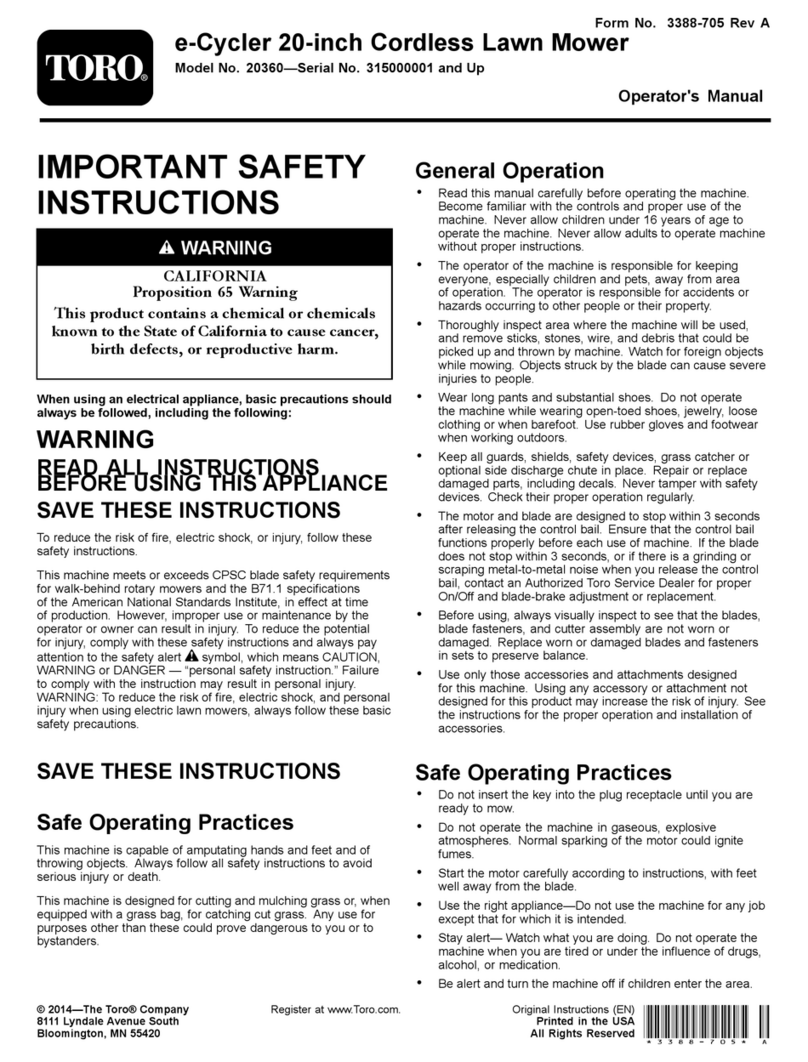
Toro
Toro e-cycler 20360 User manual
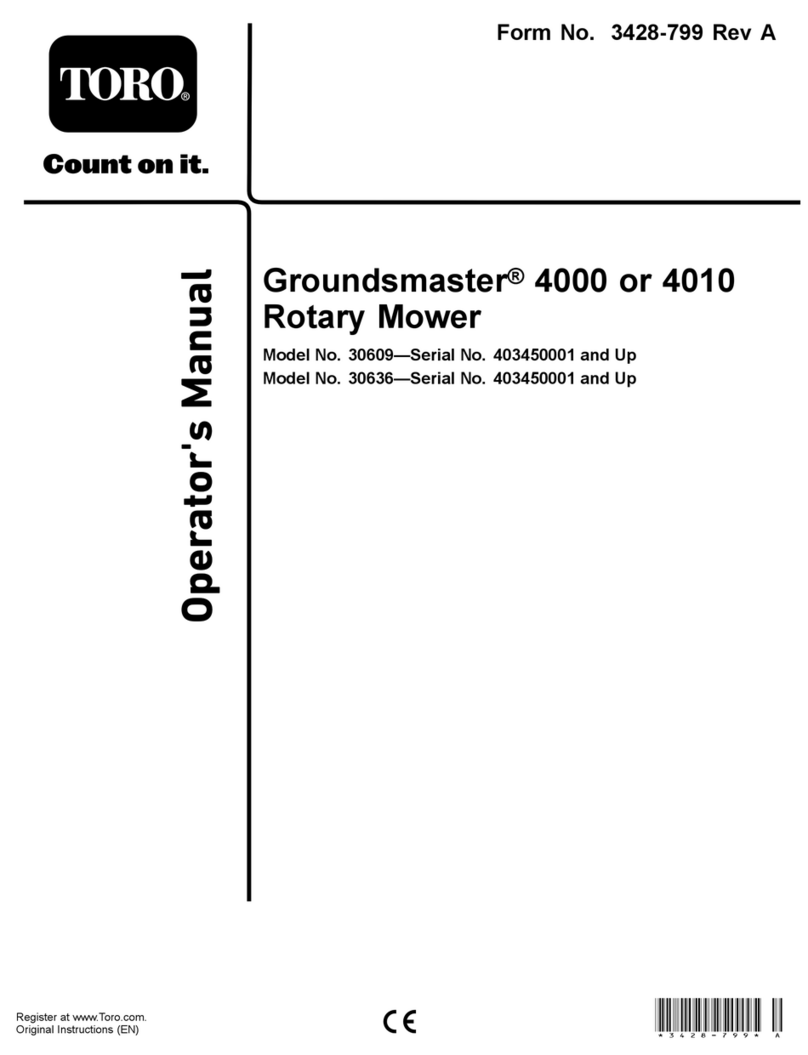
Toro
Toro Groundsmaster 4000 User manual

Toro
Toro TimeCutter 79335 User manual
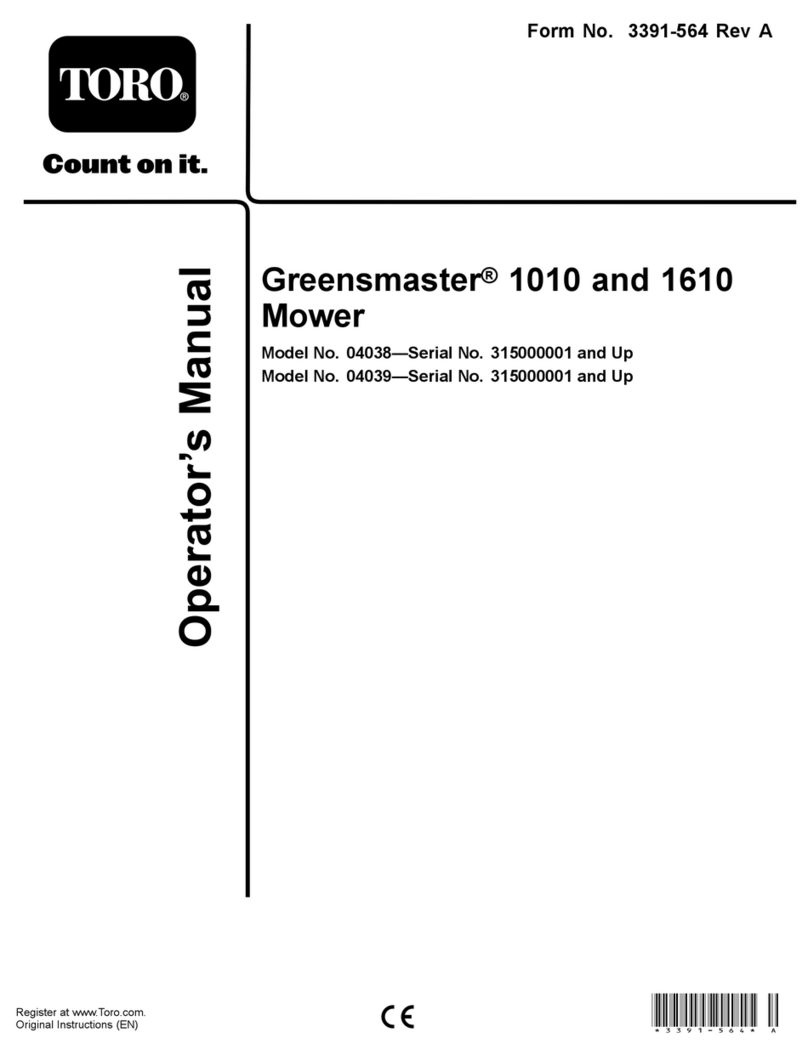
Toro
Toro 4038 User manual

Toro
Toro Recycler 20374 User manual

Toro
Toro Recyler 20353 User manual
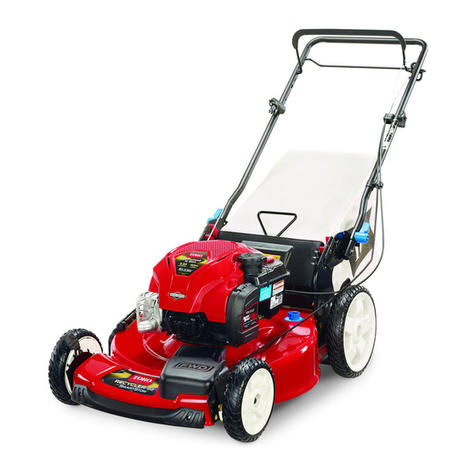
Toro
Toro Recycler 20339 User manual
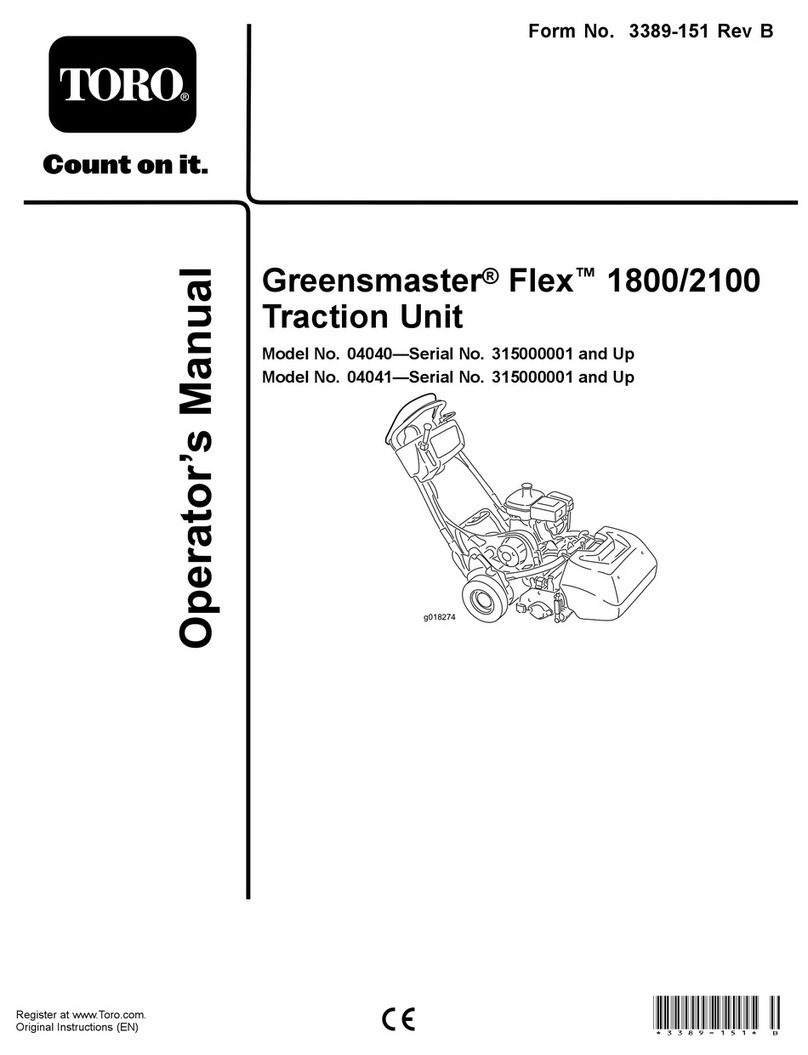
Toro
Toro Greensmaster Flex 1800 04040 User manual
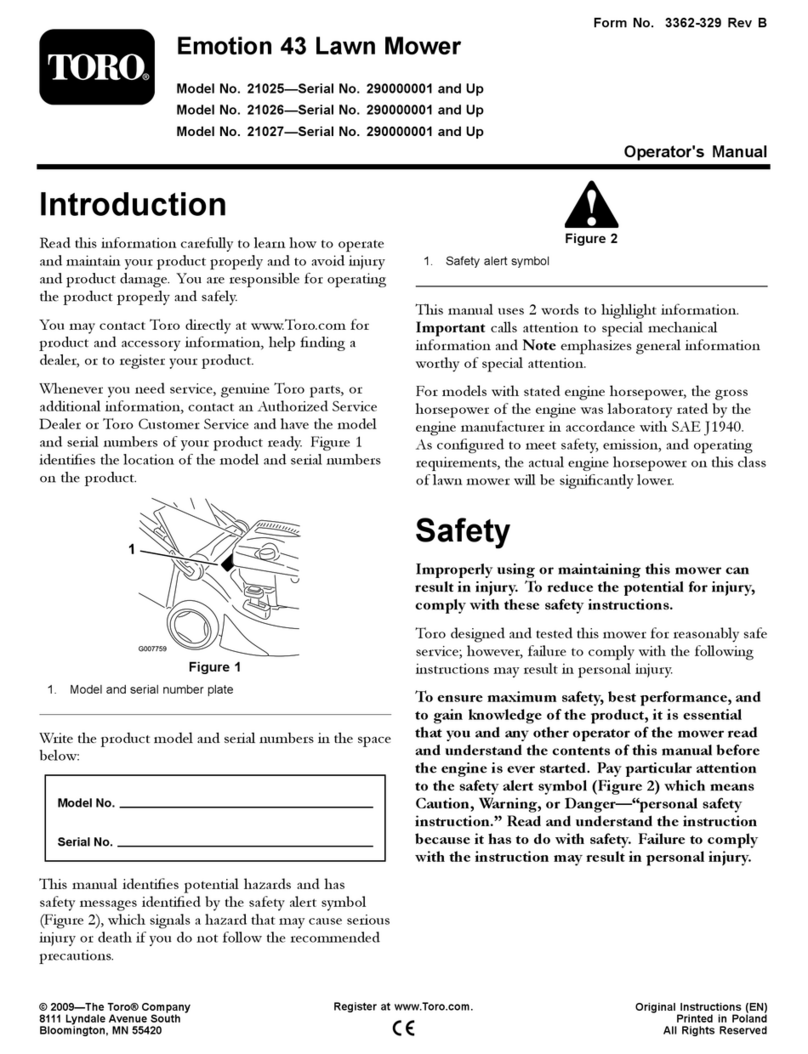
Toro
Toro 21025 User manual

Toro
Toro 74421TE User manual

Toro
Toro 79108 User manual
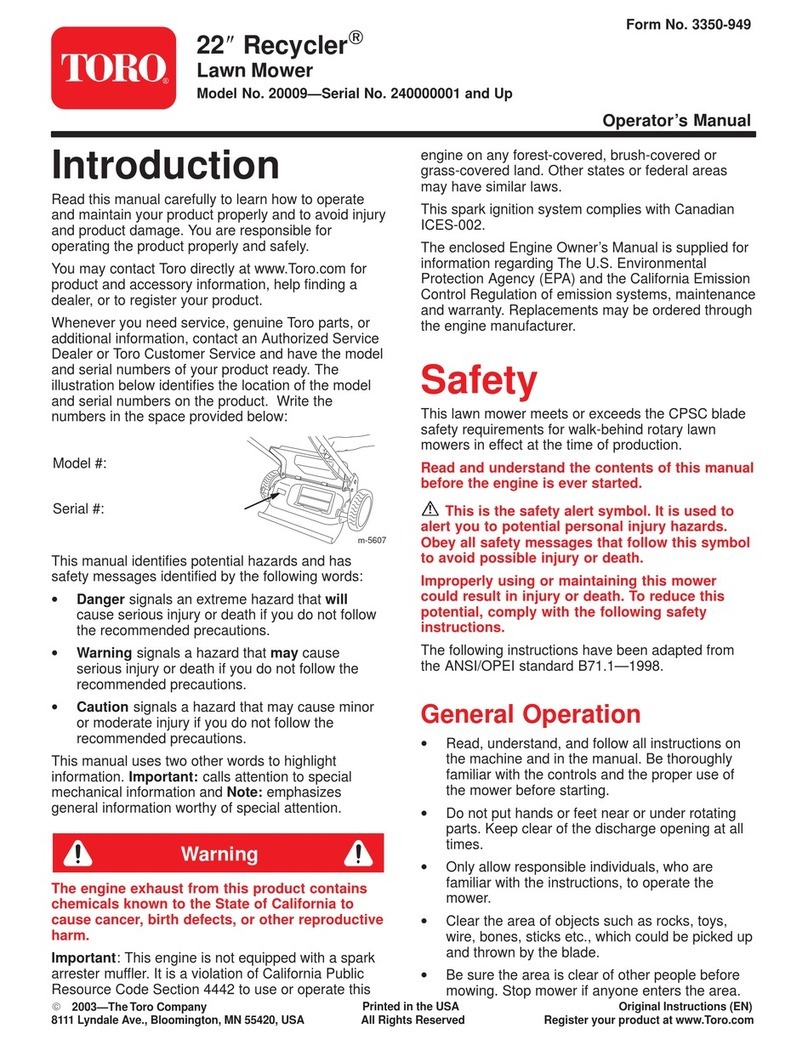
Toro
Toro Recycler 20009 User manual
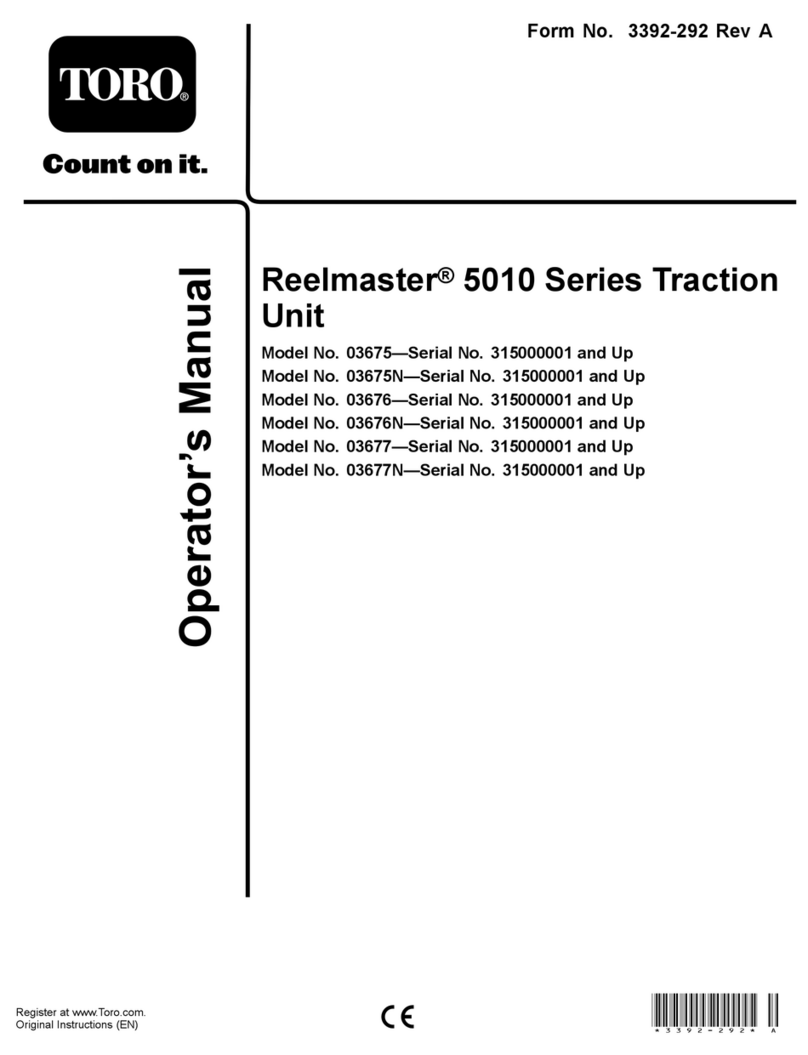
Toro
Toro 3675 User manual

Toro
Toro Recycler 20372 User manual
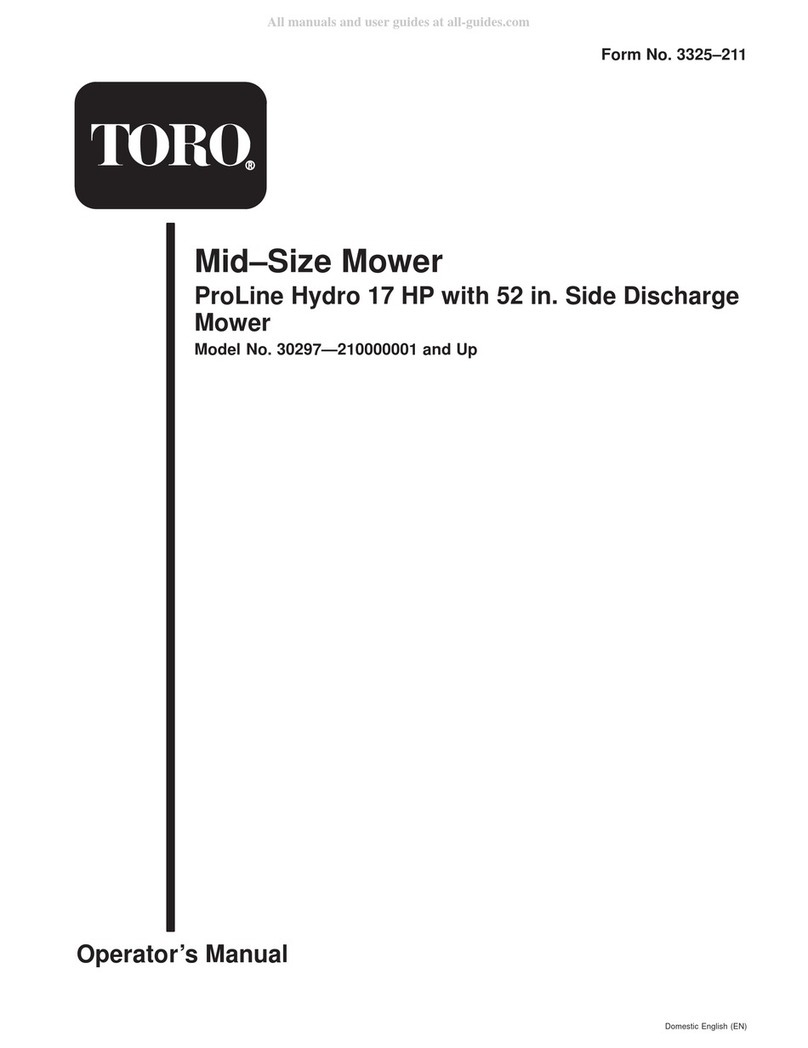
Toro
Toro ProLine Hydro 17 HP User manual
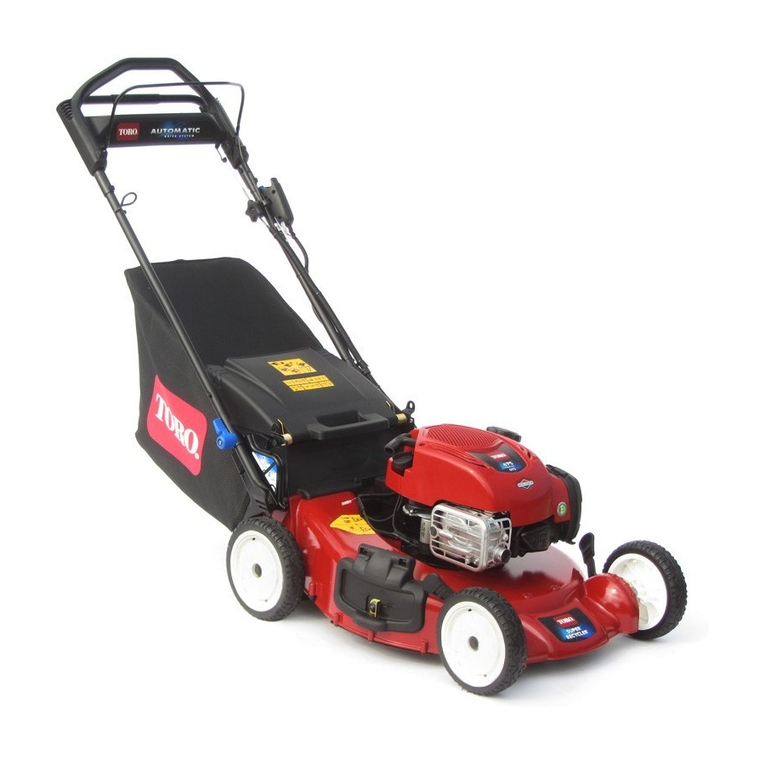
Toro
Toro Super Recycler 20797 User manual
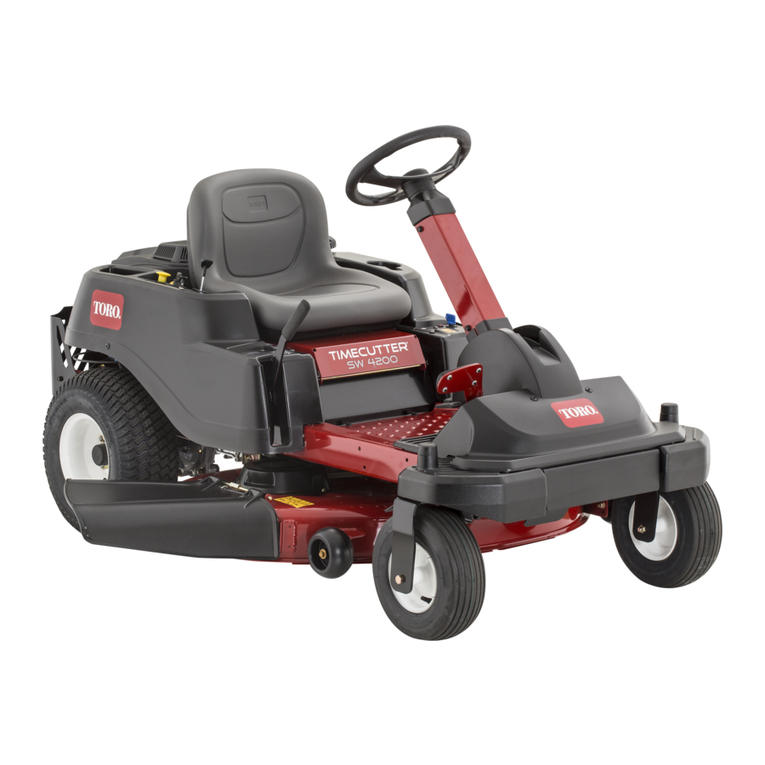
Toro
Toro TimeCutter SW 4200 User manual
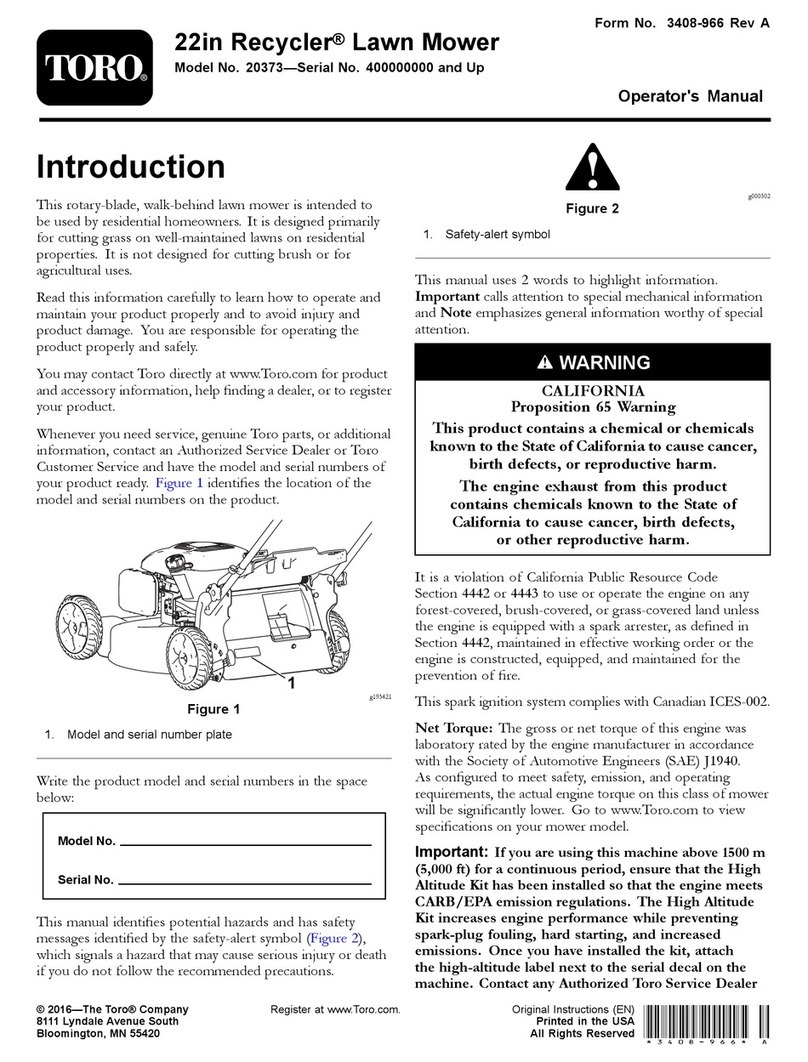
Toro
Toro Recycler 20373 User manual

Toro
Toro Z Master Professional 5000 Series User manual

